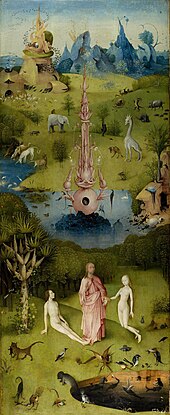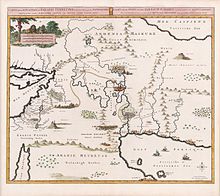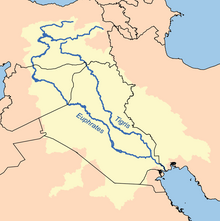Garden of Eden
Garden of Eden
From Wikipedia, the free encyclopedia
Not to be confused with Eden Gardens or Eden Garden.
For other uses, see Garden of Eden (disambiguation).
The Garden of Eden (Hebrew גַּן עֵדֶן, Gan ʿEḏen) is the biblical "garden of God", described most notably in the Book of Genesis chapters 2 and 3, and also in the Book of Ezekiel.[2][3] The "garden of God", not called Eden, is mentioned in Genesis 13, and the "trees of the garden" are mentioned in Ezekiel 31. The Book of Zechariah and the Book of Psalms also refer to trees and water in relation to the temple without explicitly mentioning Eden.[4]
Traditionally, the favored derivation of the name "Eden" was from the Akkadian edinnu, derived from a Sumerian word meaning "plain" or "steppe". Eden is now believed to be more closely related to an Aramaic root word meaning "fruitful, well-watered."[3] The Hebrew term is translated "pleasure" in Sarah's secret saying in Genesis 18:12.[5]
The story of Eden echoes the Mesopotamian myth of a king, as a primordial man, who is placed in a divine garden to guard the tree of life.[6] In the Hebrew Bible, Adam and Eve are depicted as walking around the Garden of Eden naked due to their innocence.[7] Eden and its rivers may signify the real Jerusalem, the Temple of Solomon, or the Promised Land. It may also represent the divine garden on Zion, and the mountain ofGod, which was also Jerusalem. The imagery of the Garden, with its serpent and cherubs, has been compared to the images of the Solomonic Temple with its copper serpent (the nehushtan) and guardian cherubs.[8]
Biblical narratives[edit]
Eden in Genesis[edit]
Main articles: Genesis creation narrative and Adam and Eve
The second part of the Genesis creation narrative, Genesis 2:4–3:24, opens with Adonai Elohim (the LORD God, lit. YHWH Elohim, seeNames of God in Judaism) creating the first man (Adam), whom he placed in a garden that he planted "eastward in Eden".[9]
The man was free to eat from any tree in the garden except the tree of the knowledge of good and evil. Last of all, the God made a woman (Eve) from a rib of the man to be a companion to the man. In chapter 3, the man and the woman were seduced by the serpent into eating the forbidden fruit, and they were expelled from the garden to prevent them from eating of the tree of life, and thus living forever. Cherubims were placed east of the garden, "and a flaming sword which turned every way, to keep him away from the tree of life". (Gen.3:24)
Genesis 2:10–14 lists four rivers in association with the garden of Eden: Pishon, Gihon, theTigris, and the Euphrates. It also refers to the land of Cush - translated/interpreted as Ethiopia, but thought by some to equate to Cossaea, a Greek name for the land of the Kassites.[10] These lands lie north of Elam, immediately to the east of ancient Babylon, which, unlike Ethiopia, does lie within the region being described.[11] In Antiquities of the Jews, the first-century Jewish historianJosephus identifies the Pishon as what "the Greeks called Ganges" and the Geon (Gehon) as theNile.[12]
Eden in Ezekiel[edit]
Main article: Ezekiel's cherub in Eden
In Ezekiel 28:12–19 (NIV) the prophet Ezekiel the "son of man" sets down God's word against the king of Tyre: the king was the "seal of perfection", adorned with precious stones from the day of his creation, placed by God in the garden of Eden on the holy mountain as a guardian cherub. But the king sinned through wickedness and violence, and so he was driven out of the garden and thrown to the earth, where now he is consumed by God's fire: "All the nations who knew you are appalled at you, you have come to a horrible end and will be no more." (v.19)
The Eden in Ezekiel appears to be located in Lebanon.[13] "[I]t appears that the Lebanon is an alternative placement in Phoenician myth (as in Ez 28,13, III.48) of the Garden of Eden",[14] and there are connections between paradise, the garden of Eden and the forests of Lebanon (possibly used symbolically) within prophetic writings.[15] Edward Lipinskiand Peter Kyle McCarter have suggested that the Garden of the gods (Sumerian paradise), the oldest Sumerian version of the Garden of Eden, relates to a mountain sanctuary in the Lebanon and Anti-Lebanon ranges.[16]
Proposed locations[edit]
Although the Garden of Eden is considered to be mythological by most scholars,[17][18][19][20][21][22] there have been other suggestions for its location:[23] for example, at the head of the Persian Gulf, in southern Mesopotamia (now Iraq) where the Tigris and Euphrates rivers run into the sea;[24] in Iranian Azerbaijan, and in the vicinity of Tabriz;[25]
According to the Bible, the location of Eden is described in the Book of Genesis, chapter 2, verse 10-14:
According to author Brook Wilensky-Lanford,[23] pre-Christian Jews did not consider the Garden of Eden to be a physical place, andAugustine of Hippo was the first notable Christian scholar to advance the view that it was.[26]
"The Garden of Eden" by Thomas Cole (c. 1828)
Expulsion from Paradise, painting by James Jacques Joseph Tissot
The Garden of Eden by Lucas Cranach der Ältere, a 16th-century German depiction of Eden
Map showing the rivers in the Middle East known in English as the Tigris and Euphrates.
The Garden of Eden as depicted in the first or left panel of Bosch's The Garden of Earthly Delights Triptych. The panel includes many imagined and exotic African animals.[1]
The Garden of Eden with the Fall of Man by Jan Brueghel the Elder and Pieter Paul Rubens
5th century "Garden of Eden" mosaic in mausoleum of Galla Placidia in Ravenna, Italy. UNESCO World heritage site.
Map by Pierre Mortier, 1700, based on theories of Pierre Daniel Huet, Bishop of Avranches. A caption in French and Dutch reads: Map of the location of the terrestrial paradise, and of the country inhabited by the patriarchs, laid out for the good understanding of sacred history, by M. Pierre Daniel Huet.
















Comments
Post a Comment